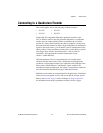
Chapter 2 Power and I/O
NI 17xx Smart Camera User Manual 2-6 ni.com
Protecting Against Inductive Loads
When an inductive load, such as a relay or solenoid, is connected to an
output, a large counter-electomotive force may occur at switching time due
to energy stored in the inductive load. This flyback voltage can damage the
outputs and the power supply.
To limit flyback voltages at the inductive load, install a flyback diode across
the load. Mount the flyback diode as close to the load as possible. Use this
protection method if you connect any of the isolated outputs to an inductive
load.
Connecting to Serial Devices
Use the RS232_RXD and RS232_TXD signals on the POWER-I/O
connector for serial communication. Connect the RS232_RXD signal on
the NI Smart Camera to the Tx signal on your serial device. Connect the
RS232_TXD signal on the smart camera to the Rx signal on your serial
device. Connect COM on the smart camera to the ground of your serial
device.
When the CONSOLE DIP switch is in the OFF position, you can use the
NI-Serial driver for serial communication. You must install the NI-Serial
software on the smart camera; it is not installed by default. Refer to the
Serial Hardware and Software Help for information about installing the
NI-Serial software on LabVIEW Real-Time targets, such as the smart
camera. To open this document, navigate to Start»All Programs»
National Instruments»NI-Serial»NI-Serial Help.
Communicating with the Console
When the CONSOLE DIP switch is in the ON position, you can read device
information from the NI Smart Camera during startup, such as the
IP address and firmware version, through a serial port terminal program.
Ensure that the serial port terminal program is configured to the following
settings:
• 9,600 bits per second
• Eight data bits
• No parity
• One stop bit
• No flow control


















